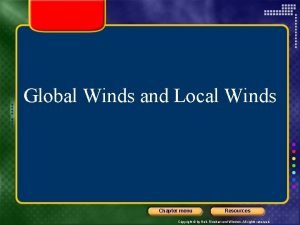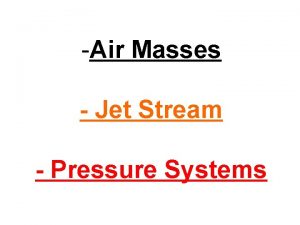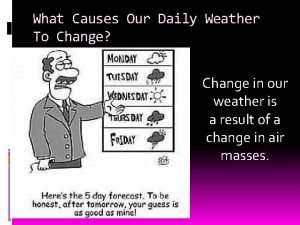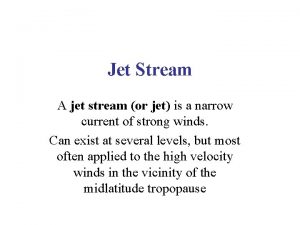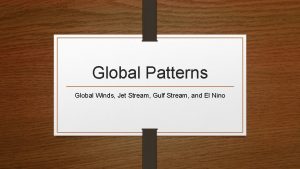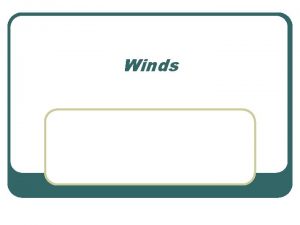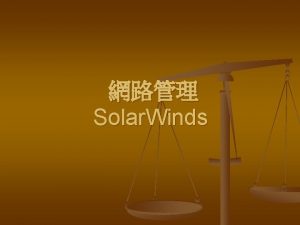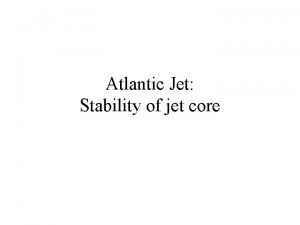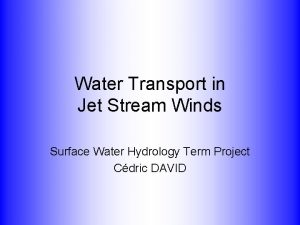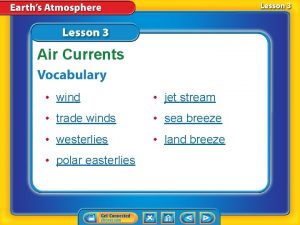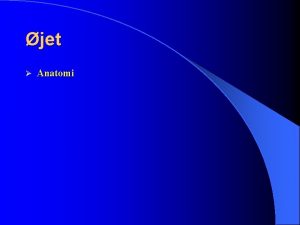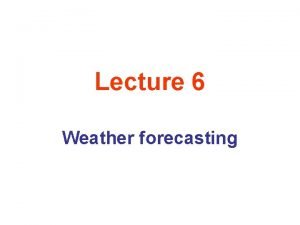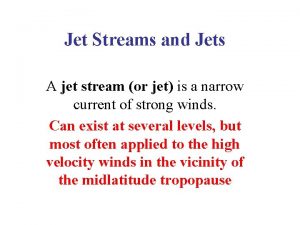Jet Stream An area of strong winds that























- Slides: 23

Jet Stream An area of strong winds that are concentrated in a relatively narrow band in the upper troposphere of the middle latitudes and subtropical regions of the Northern and Southern Hemispheres. Flowing in a semi-continuous band around the globe from west to east, it is caused by the changes in air temperature where the cold polar air moving towards the equator meets the warmer equatorial air moving polarward. It is marked by a concentration of isotherms and strong vertical shear. (from AMS)

Jet Stream (NH)

Jet Stream From the Coriolis Force point of view: Westerly Wind Cold air North West East Trade Wind Equator Warm air Westerly wind (upper levels): Wind blows from west Trade wind (low levels): Wind blows from northeast

Jet Stream From thermal wind balance point of view: -10 o. C cold -5 o. C VT Vg 2 VT=Vg 2 -Vg 1 0 o. C Vg 1 5 o. C warm

Thermal Wind The (vector) difference between the wind at two levels (pressure levels). Consider, the case of no wind near the surface (the 1000 mb surface is horizontal) and a temperature pattern with a uniform north-to-south gradient up to the 500 mb level. X

Thermal Wind Vertical cross-section (x-z plane) z Vg 2 VT Vg 2: geostrophic wind at upper level Vg 1: geostrophic wind at lower level Vg 1=0 E W Top view W N Cold air VT Warm air S VT=Vg 2 -Vg 1 E Since Vg 1=0, VT=Vg 2 The difference in wind between the two levels (the thermal wind) relates to the temperature pattern (cold temperature on the left) the same way that the geostrophic wind relates to the pressure pattern (low pressure on the left).

Jet Stream From thermal wind balance point of view: z S-N temperature gradient results from the energy unbalance between the long-wave and short-wave radiation at different latitudes. E W In midlatitude, westerly wind has to increase with height in order to maintain thermal wind balance (geostrophic + hydrostatic balances) N E Cold air Warm air Equator W Maximum wind occurs below the level where temperature gradient changes the sign (tropopause)

Jet Stream (J) Temperature field: isotherms clear-air turbulence!

Jet Stream (NH)

Jet Stream (SH)

Jet Streak A region of accelerated wind speed along the axis of a jet stream. Entrance Exit Dashed lines: isotachs

Jet Streak

Jet Streak

Jet Streak (Quasi-Geostrophic theory) Low pressure High pressure Pressure gradient force Coriolis force Low pressure IC D III II D C IV High pressure Ageostrophic wind I : Convergence II : Divergence III: Divergence IV : Convergence

Jet Streak (Entrance) l Co e c n ra t n E t Exi r i A d Div Con Div W m ar Direct thermal circulation r Ai

Jet Streak (Exit) l Co e c n ra t n E t Exi r i A d Div Con Div W m ar r Ai Indirect thermal circulation

Jet Streak and low-level cyclones Direct thermal circulation ld Co r Ai Con n I Co Div II r t n E e anc Div III W m ar r Ai t Exi IV Indirect thermal circulation

Jet Streak and low-level cyclones Direct thermal circulation Adiabatic warming ld Co r Ai Con n I Co Div II e anc W r t n E Adiabatic cooling Reduce horizontal T gradient Adiabatic III cooling Div m ar r Ai t Exi IV Indirect thermal circulation Adiabatic warming Enhance horizontal T gradient Region III is better than Region II for low-level cyclones to develop!

Tropopause Folding Troposphere and stratosphere exchange air Folding of the tropopause with direct ageostrophic circulation around the jet stream (entrance of a jet streak)

Global Circulation

Polar Front

Polar Front

Polar Front Polar jet stream and polar front Solid lines : isotachs Dashed lines: isotherms The break in the tropopause is associated with the vertical frontal layer
 Ephesians 6:10-20 nkjv
Ephesians 6:10-20 nkjv Nullschool global wind
Nullschool global wind How do local winds and global winds differ?
How do local winds and global winds differ? What is the difference between global and local winds?
What is the difference between global and local winds? Local and global winds
Local and global winds How are global winds and local winds different
How are global winds and local winds different Yelvington jet aviation aircraft fuel
Yelvington jet aviation aircraft fuel Jet stream
Jet stream Jet stream
Jet stream Source regions for air masses
Source regions for air masses The polar front jet stream blows ____.
The polar front jet stream blows ____. Jet stream
Jet stream Oaks grow strong in contrary winds
Oaks grow strong in contrary winds Differentiate byte stream and character stream
Differentiate byte stream and character stream Tôn thất thuyết là ai
Tôn thất thuyết là ai Walmart thất bại ở nhật
Walmart thất bại ở nhật Gây tê cơ vuông thắt lưng
Gây tê cơ vuông thắt lưng Block xoang nhĩ
Block xoang nhĩ Phân độ lown
Phân độ lown Tìm độ lớn thật của tam giác abc
Tìm độ lớn thật của tam giác abc Sau thất bại ở hồ điển triệt
Sau thất bại ở hồ điển triệt Thơ thất ngôn tứ tuyệt đường luật
Thơ thất ngôn tứ tuyệt đường luật Hãy nói thật ít để làm được nhiều
Hãy nói thật ít để làm được nhiều Thơ thất ngôn tứ tuyệt đường luật
Thơ thất ngôn tứ tuyệt đường luật





